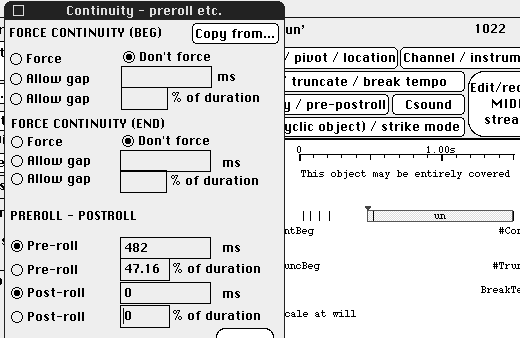Pre-roll
and post-roll
These
words are familiar to folks working on sound or video editing. On a tape
recorder in pause-recording mode, the pre-rol
l
is the delay between the moment the pause button is released and the moment the
recording actually starts. Similarly, the post-rol
l
is the delay between the time the pause button is pushed and the one it
actually stops recording. With automatic editing devices such as VideoDirector,
these mechanical parameters may be entered in the program's settings so that
the program compensates them and achieves accurate timings.
Pre-roll
In
BP2, the
pre-roll
of a sound-object is the delay between its first event (Csound event or MIDI
message) and the beginning of its time-span interva
l.
The
first event is the one that tells the sound processor to start
,
whereas
the
beginning of the time-span interval is the moment when the listener feels it
actually started
.
A
positive pre-roll allows some events to fall before the on-setting tim
e
of the sound-object. This is useful when the sound-object contains an
initialisation sequence that should not be accounted in its time-span interval.
Fig.7
shows a sound-object labelled 'un' with 482ms of fixed pre-roll.
Fig.7
A sound-object with positive pre-roll
On
the graphic (right part of Fig.7), events are shown as short vertical lines.
Four events are located outside to the left of the time-span interval.
Post-roll
In
BP2, the
post-roll
is the delay between the last MIDI message of a sound-object and the end of its
time-span interva
l.
A
negative post-roll allows some events to fall beyond the off-setting time of a
sound-object. This may be useful if the sound-object contains a final sequence
of events that should not be part of its time-span interval.
A
positive post-roll is the proper way of compensating a mechanical delay in
setting-off the sound device. If for instance the event sequence in the
sound-object ends with a NoteOff and the device takes 50ms to react, then
setting the post-roll to 50ms will append a 50ms silence after the sound-object
to allow the device to finish its job. This is generally combined with a
positive pre-roll compensating on-setting delays.
An
important formula
=
date of last event - date of first event - pre-roll + post-roll

